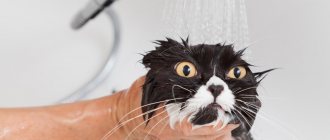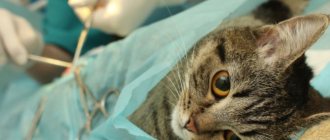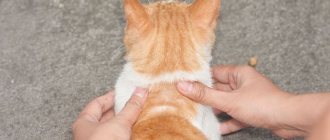Performing the procedure to remove reproductive organs in cats is not particularly difficult for a specialist. In order to minimize the risks of possible complications and pathological conditions in the animal after surgery, it is necessary to properly prepare the cat for sterilization. The main points that the pet owner must carry out independently are timely vaccination and antiparasitic treatment (destruction of ectoparasites and worms). It is also important to keep the animal on a fasting diet for at least 12 hours before surgery.
Pros and cons of sterilization
Sterilization, like any surgical process, has advantages and disadvantages.
The arguments “For” include the following arguments:
- a cat is capable of bringing kittens not only annually, but even quarterly, up to 6 kittens at a time. Not all owners want to solve the problem of finding homes for all their children;
- the behavior of an animal during estrus is often inadequate: nighttime guttural cries, lack of appetite, a pervasive smell of urine in the house due to the cat’s desire to mark everything around with its smell;
- if there are babies in the house, a sterilized animal will not bring infection into the house;
- bearing and giving birth to offspring can cost the life of the owner’s beloved cat;
- if a cat is not allowed near the cat during heat, then a large amount of extra hormones appears, which has a detrimental effect on the pet’s psyche;
- increasing the lifespan of a cat.
It is also worth listening to the arguments “against” and drawing conclusions: this is an invasion of the natural course of events planned by nature. It turns out that a person first of all worries about his own peace of mind, and only then about the health of his pet.
The operation may not go as smoothly as we would like; it is difficult for the animal to recover from anesthesia and regain strength.
It is also important to understand that sterilization of a cat is an irreversible process, and the owner will never see kittens from his pet.
How to properly examine a cat before castration?
Even healthy cats and female cats that do not show symptoms of any diseases are recommended to undergo regular medical examinations by a veterinarian. This is due to the fact that an animal, especially one as secretive as a cat, does not always show signs of illness in the early stages.
Many pathologies, for example, chronic renal failure, at stages 1 and 2 of development cannot be determined clinically, but only by the results of blood tests. Also, sometimes owners of cats and cats can attribute the symptoms of certain diseases to the individual character traits of their pet (for example, incipient lethargy and loss of appetite are attributed to the phlegmatic mentality of the animal).
Failure to diagnose a serious disease can affect the course of the operation in the most unpleasant way. Therefore, before such an important step as cat castration surgery, it is so important to completely exclude all possible pathologies. To do this, after a clinical examination of the cat, which includes examination, temperature measurements, assessment of heartbeat and respiration and other vital parameters, the veterinarian will suggest that the owners undergo clinical and biochemical blood and urine tests, as well as undergo an ultrasound of the heart from a cardiologist.
The results of blood tests may indicate a possible inflammatory process, a decrease in the animal’s blood in the number of cells responsible for saturating the body with oxygen, as well as possible organ pathologies. All of these situations are contraindications for surgery, and in this case the cat must undergo further diagnosis and treatment before the veterinarian allows him to be castrated.
If the test results are normal, the veterinary cardiologist will perform an ultrasound of the cat’s heart in preparation for castration. This procedure can be performed either in advance or directly on the day of castration. Ultrasound of the heart is a diagnostic method that allows you to most accurately assess the functions of the chambers and the functioning of the muscular-contractile system of the heart in dynamics. This study is especially relevant for older cats and cats belonging to breeds at risk for cardiovascular diseases due to inherited pathologies (Maine Coon, British, Scottish, Sphynx, Ragdoll).
When to spay a cat
global $ads_google;
//data-ad-slot=”2475549904″ $ads_google = empty($ads_google) ? false : true; ?> if ($ads_google == false) {?> $ads_google = true; ?> } ?> At a young age, the operation is easier and more successful: the recommended age of the animal is 8-12 months. The cat is taken to the veterinarian for examination, because it is important to make sure that the pet is physically healthy and developed. Early surgery may cause developmental delays in the animal.
It is also possible to perform sterilization during estrus. But during this period, due to the large amount of hormones in the cat’s body, it will be difficult to recover from anesthesia, and the sutures may take longer to heal than usual. The best time to perform the operation is a couple of weeks before the hunting period or two weeks after it.
If estrus lasts a long time, interrupting only for 2-4 days, then it becomes difficult to find the time. In this case, the pet is sterilized to prevent excessive depletion of its body.
Another important question that concerns some owners: is it possible to sterilize a pregnant cat ?
There is a separate name for this process: extirpation of the pregnant uterus. Surgery is performed in emergency cases that require saving the cat's life.
Types of cat sterilization
There are several ways to perform the operation: chemical and surgical.
- Tubal occlusion: The cat's fallopian tubes are ligated, eliminating the possibility of pregnancy. Although the intervention is surgical, the reproductive organs are not removed.
- Sterilization is classic - along the white line of the abdomen or an alternative option: through a side incision. In this case, the incision is made on the side, and the muscles are separated using a blunt method. Although the method is less traumatic than the previous one, the uterus is not always completely removed. No seam maintenance is required. An intradermal suture allows the cat to immediately resume its usual lifestyle, gradually restoring its health.
- Sterilization through a very small incision using a surgical hook. A synonym is laparoscopic sterilization, which is not entirely correct, since the peritoneum and skin are also cut, but with a much smaller incision along the length. A disinfected hook is inserted into the wound and used to hook the ligament to the ovary. A ligature is applied and the ovary with a ligament or the entire uterus is removed.
- Laparoscopy as sterilization (ecdoscopic): Thanks to endoscopic technologies, punctures are made in the skin of the abdominal wall and the uterus and ovaries are completely removed. Expensive equipment is used, so the cost of the operation remains high.
- Chemical method or temporary sterilization: a special implant containing a drug is inserted under the animal’s skin. The substance gradually enters the bloodstream and the cat develops a reversible sterilization effect for up to three years.
They choose the appropriate method responsibly: they study veterinary clinics and reviews of them from professional breeders. Saving money and haste are bad advisors in this matter.
Castration of a cat
If during sterilization , which is also called oophorectomy (OE), the ovaries are surgically removed, then during castration both the ovaries and the uterus are removed. Such intervention in the body can be planned or according to indications. There are no contraindications for castration based on the age of the cat.
How is laparoscopic sterilization performed?
After putting the animal under anesthesia, an incision of about 1 cm is made in order to insert a hook into the abdominal cavity. This device moves the intestinal loops and picks up the uterine horn. The uterus along with the ovaries are pulled out through a tiny wound.
This is possible due to the elasticity of cat tissues, especially at a young age.
Then the pulled out organs are strongly pulled out to apply a ligature to the arteries of the ovaries and ligaments, as well as to the horns of the uterus. The process of stretching is very serious, because in fact it is on the verge of breaking the ovarian ligament.
The uterus is cut off and removed, the centimeter incision is sutured: such a seam is not processed or covered with a blanket, since the cat will not be able to lick it.
Preparing a cat for sterilization
global $ads_google;
//data-ad-slot=”2475549904″ $ads_google = empty($ads_google) ? false : true; ?> if ($ads_google == false) {?> $ads_google = true; ?> } ?> The process of preparing for the operation is taken with the utmost seriousness, because general anesthesia is used.
Be sure to follow all the recommendations of the veterinarian!
Before surgery, tests and ultrasound may be prescribed, and a visit to a cardiologist and therapist is recommended. Such precautions serve to ensure the safety of the animal and the doctor’s confidence in the absence of unpleasant surprises during work. Such precautions are relevant for cats over 10 years of age due to possible pathologies of internal organs.
Before sterilization, the cat should not eat for 8 to 12 hours, and 3 hours before the operation the animal is not allowed to drink, otherwise severe vomiting will occur during the induction of anesthesia. Vomit easily enters the respiratory tract, introducing various types of bacteria.
For everything to go well, you must comply with all the requirements for preparing your pet for anesthesia.
Why is it necessary to examine a cat before castration?
Castration of a cat falls into the category of minimally invasive surgical operations. This is due to the technical simplicity of the procedure itself - to remove the testes, the surgeon only needs to cut the skin and several thin membranes of the scrotum. Accordingly, for an experienced surgeon, the castration process takes less than 5 minutes, and the animal is under anesthesia for very little time.
However, even such a short period of entering anesthesia sleep has its anesthetic risks. For animals with congenital or acquired pathologies of the cardiovascular system or diseases of internal organs (for example, chronic renal failure), a decrease in blood pressure while under anesthesia can be fatal. Therefore, before any surgical intervention that requires anesthesiological support and induction of anesthesia, it is important to exclude possible diseases or tendencies to manifest certain pathologies, even in animals whose owners do not report any ailments.
Sterilizing a cat at home
The procedure for sterilizing a pet at home is no different from the same operation, but in a clinic. Everything is going according to plan:
- Examination of the pet's health, including urine, blood, ECG, and ultrasound tests.
- Preparation for the chosen method of operation: stop feeding your pet 8-12 hours before the due date, and drinking 3 hours before the start of action.
- Introducing an animal into anesthesia.
- Carrying out surgery, suturing.
- The postoperative period consists of caring for the cat immediately after it comes out of anesthesia.
It is important to ensure that your pet does not lick the seam even through the blanket.
Carrying out antihelminthic measures
Any qualified veterinarian will tell you that it is necessary to remove worms before neutering. Such treatment is desirable every 3 months; for pets that eat dry food and do not go outside, intervals of up to 4 months are possible. Removal of skin parasites (ticks, lice, etc.) is usually carried out as necessary.
When you plan to sterilize, you need to carry out deworming treatment approximately 10-12 days in advance. However, if you did this no more than a month ago, you can skip this step - re-application of the anthelmintic is not required.
Caring for a cat after sterilization
While a cat is under anesthesia, its body temperature is reduced, so when it comes out of this state, it is important to provide warmth to the animal, using a blanket. The cat is placed on a bed on the floor - the animal may fall or hit itself from higher objects. An absorbent diaper is placed under the animal: urination is not yet controlled.
It is also important to take care of the animal’s eyes: they are open during anesthesia, and to prevent the cornea from drying out, it is better to periodically drip “artificial tears” or regular saline into the eyes.
Since the anesthesia lasts for some time, the cat can jump up and run, jump on furniture, and due to a violation in the coordination of movements, it needs an eye and an eye.
All doctor’s recommendations must be followed impeccably, because the restoration of the cat’s health depends on this.
In order to prevent inflammatory processes in the body, antibiotic therapy may be prescribed. Long-acting antibiotics are used, such as Sinulox, amoxoil, amoxicillin. A pair of injections are required, spaced 48 hours apart.
After sterilization, the cat recovers in about 10 days. Some clinics offer hospitalization of the animal for the entire recovery period under the supervision of specialists.
Feeding the cat
The first drink is given to the animal 5-7 hours after the operation, and after abdominal surgery the cat needs to be sealed off with a pipette. The laparoscopic method is easier to tolerate, and the pussy can drink on its own.
The first feeding is offered after 17-20 hours: the animal may be very hungry. But some fluffies refuse to eat for the first 3 days, but then they quickly begin to eat away.
To prevent a cat's excessive appetite from becoming a cause of obesity, the owner must strictly monitor its diet.
Suture after sterilization
global $ads_google;
//data-ad-slot=”2475549904″ $ads_google = empty($ads_google) ? false : true; ?> if ($ads_google == false) {?> $ads_google = true; ?> } ?> The cat should under no circumstances lick the seam. Over a long week of wearing a blanket, the animal is able to wipe the fabric right through. The seam is inspected daily: there should be no discharge. The ideal condition of the seam means that it is clean and dry.
Treatment of sutures after sterilization includes daily wiping with an antiseptic solution (chlorhexidine, hydrogen peroxide, dioxide are suitable). It will not be superfluous to lubricate the seam with wound-healing ointment.
If there is any discharge from the suture, immediately contact a veterinary clinic.
There are types of sutures that do not require treatment; the doctor who performed the operation will inform you about this.
Sometimes the sutures look somewhat swollen - this is physiological swelling of the tissues, which will subside in 2-3 days.
The stitches are removed after 7-10 days.
If the cat still asks for the cat
The operation was successful, but the cat still wants a cat? There may be several reasons for this:
- tubal occlusion was performed or only the uterus was removed. In this case, the cat will not be able to bear offspring, but the production of sex hormones continues, hence the cat’s desire;
- The lack of professionalism of the veterinarian causes incomplete removal of the ovaries - even a small part left in the body will produce sex hormones. An abandoned ovary can be detected by ultrasound or gonadotropin test. This requires repeat surgery;
- with rare heredity, ectopic ovarian tissue syndrome occurs, when this organ is located in a place not intended by nature, which makes it very difficult for a doctor to find it.
- sex hormones can be produced by the pituitary gland and adrenal glands if the cat has already given birth;
- the presence of a hormone-producing tumor in the animal’s body.
Before starting to worry, wait a month after the operation and only then consult a doctor.
When can I take my cat home?
Although the operation itself to castrate a cat takes only a few minutes, about an hour and a half to two hours after it, the anesthesiologist observes how the animal comes out of anesthesia and the stabilization of its breathing and heartbeat. Therefore, you can take your pet home no earlier than two hours later.
Owners are given only a fully awake animal, capable of walking independently and adequately perceiving reality. In this case, the cat’s sexual instinct will already be suppressed. The veterinarian will tell you how the operation went and give all the necessary recommendations for the care and maintenance of the cat after castration.











